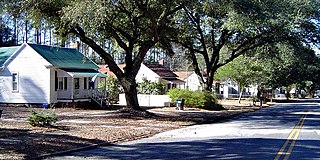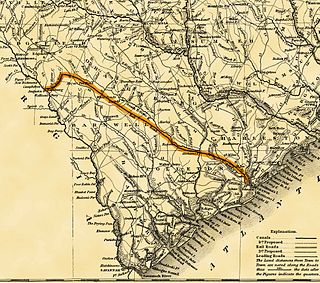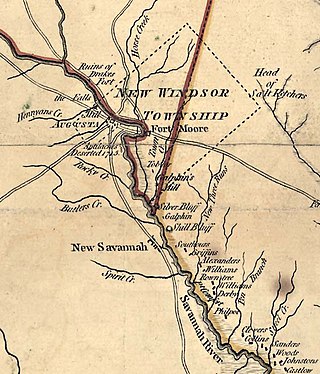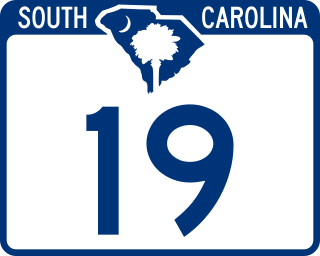
Edgefield County is a county located on the western border of the U.S. state of South Carolina. As of the 2020 census, its population was 25,657. Its county seat and largest municipality is Edgefield. The county was established on March 12, 1785.

Aiken County is a county in the U.S. state of South Carolina. As of the 2020 census, its population was 168,808. Its county seat and largest city is Aiken. Aiken County is a part of the Augusta-Richmond County, GA-SC Metropolitan Statistical Area. It is mostly in the Sandhills region, with the northern parts reaching in the Piedmont and southern parts reaching into the Coastal Plain.

Aiken is the largest city in, and the county seat of, Aiken County, in western South Carolina. It is one of the two largest cities of the Central Savannah River Area. Founded in 1835, Aiken was named after William Aiken, the president of the South Carolina Railroad. It became part of Aiken County when the county was formed in 1871 from parts of Orangeburg, Lexington, Edgefield, and Barnwell counties.

Edgefield is a town in Edgefield County, South Carolina, United States. The population was 4,750 at the 2010 census. It is the county seat of Edgefield County.

North Augusta is a city in Aiken and Edgefield counties in the U.S. state of South Carolina, on the north bank of the Savannah River. The population was 24,379 at the 2020 census. The city is included in the Central Savannah River Area (CSRA) and is part of the Augusta, Georgia, metropolitan area.

Hamburg, South Carolina is a ghost town in Aiken County, in the U.S. state of South Carolina. It was once a thriving upriver market located across the Savannah River from Augusta, Georgia in the Edgefield District. It was founded by Henry Shultz in 1821 who named it after his home town in Germany of the same name. The town was one of the state's primary interior markets by the 1830s, due largely to the fact that the South Carolina Canal and Rail Road Company chose Hamburg as the western terminus of its line to Charleston.

Graniteville is a census-designated place (CDP) in Aiken County, South Carolina, United States. The population was 2,614 at the 2010 census. It lies along U.S. Route 1, five miles (8.0 km) west of Aiken in Horse Creek Valley, which originates in the nearby town of Vaucluse.

The Graniteville train crash was an American rail disaster that occurred on January 6, 2005, in Graniteville, South Carolina. At roughly 2:40 am EST, two Norfolk Southern trains collided near the Avondale Mills plant in Graniteville. Nine people were killed and over 250 people were treated for toxic chlorine exposure. The accident was determined to be caused by a misaligned railroad switch.

Vaucluse is an unincorporated community in Aiken County in the U.S. state of South Carolina. Vaucluse is part of the Augusta, Georgia metropolitan area.

The South Carolina Canal and Rail Road Company was a railroad in South Carolina that operated independently from 1830 to 1844. One of the first railroads in North America to be chartered and constructed, it provided the first steam-powered, scheduled passenger train service in the United States.

Savannah Town, South Carolina is a defunct settlement that was located in the colonial years on the Savannah River below the Fall Line in present-day Aiken County. In the 1670s the Westo had a village here, but they were displaced by the Savannah in a trade war, and it became known by 1685 as Savannah Town. The English colony had traders who did a lucrative business in dressed skins with the Savannah Shawnee. Fortified as a frontier post, the settlement developed and ferry service was established across the river. The town was gradually overtaken by its competitor of Augusta, Georgia, established in 1735 five miles upriver and closer to Indian settlements. Traders here intercepted commerce, sending it to their port of Savannah on the coast. By 1740 Savannah Town was declining, and by 1765 the village was abandoned and the fort closed.

William Gregg was an ardent advocate of industrialization in the antebellum Southern United States and the founder of the Graniteville Mill, the largest textile mill in South Carolina during the antebellum period. Gregg was a revolutionary figure in the textile industry. His practice of having his employees live in company-owned homes became common.

Ellenton is a former community that was located on the border between Barnwell and Aiken counties, South Carolina, United States. Ellenton was settled c. 1870.
Henry Woodward, was a Barbados-born merchant and colonist who was one of the first white settlers in the Carolinas. He established relationships with many Native American Tribes in the American southeast. He initiated trade, primarily in deerskins and slaves, with many Indian towns and tribes.

The Sibley Mill is a historic building located on the Augusta Canal at 1717 Goodrich Street near downtown Augusta, Georgia, United States. Designed by Jones S. Davis, it was built on a site previously occupied by the Confederate Powderworks, and was completed in 1882. While the interior is typical of any textile mill of the period, its imposing exterior is notable for an ornate style variously described as eclectic and neo-gothic. Textile products were produced there until 2006, since when the building has been unoccupied. The mill was built to operate on hydropower, and continues to generate electricity today.
Warrenville is a census-designated place (CDP) in Aiken County, South Carolina, United States. The population was 1,233 at the 2010 census. It is located just south of Graniteville and is part of the Augusta, Georgia metropolitan area. Warrenville is located in historic Horse Creek Valley.
The Midland Valley area is a region in Aiken County, South Carolina consisting of the unincorporated communities of Gloverville, Graniteville, Langley, Vaucluse, Warrenville, Graniteville, Bath, as well as the incorporated town of Burnettown

The Graniteville Historic District encompasses one of the first textile company towns to be established in the Southern United States. Built in the late 1840s by William Gregg near Aiken, South Carolina, and now known as Graniteville, it was modeled after New England mill towns. Gregg used the success of this enterprise to advocate for the industrialization of the South, laying the groundwork for its eventual domination of the American textile industry. The district, which includes the original canal, mill building, mill worker housing, and a period church, was designated a National Historic Landmark District in 1978.

South Carolina Highway 19 (SC 19) is a 28.750-mile (46.269 km) primary state highway in the U.S. state of South Carolina. It connects Aiken directly with the Savannah River Site and Edgefield via U.S. Route 25 (US 25).

South Carolina Highway 191 (SC 191) is a 21.930-mile-long (35.293 km) state highway in the U.S. state of South Carolina. The highway connects Warrenville and Johnston.

















